Nail Gun Buying Guide – Which Type Do You Need To Buy?
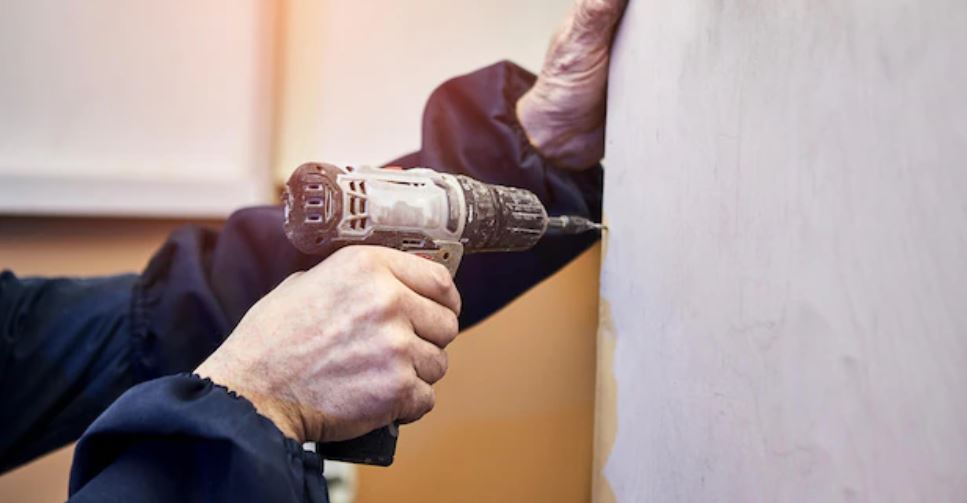
Driving a nail is a practice that is as old and as essential as language itself.
If we were unable to effectively drive nails, we would have no homes, schools, hospitals, offices, furniture…well you get the idea.
And while the act of driving a nail is fairly basic, the way we do it is anything but. Today, we have power tools called nail guns.
A nail gun essentially replaces the hammer in the task of driving nails into wood and metal.
Nail guns allow us to drive nails with more force and speed than with a hammer alone. They allow us to get large projects done in half the time.
They also make the task of driving nails a bit safer and easier on our bodies.
And if you’ve ever handled a nail gun before, then you probably know that these tools can be pretty fun to boot. But the world of nail guns may be more expansive than you realize.
There are a lot of different kinds of nail guns and different types are necessary in different situations. In the following article, we will be talking all about nail guns and helping you find the right one for your needs.
While nail guns can be extremely helpful, you have to practice discernment when purchasing one. There are a lot of different types of nail guns and each one is suited to a certain kind of job or application.
Choosing the right nail gun will allow you to work quicker, smarter and more efficiently.
So join us as we discuss everything you need to know before purchasing your own nail gun.
How Do Nail Guns Work?
First things first: let’s talk about the basic mechanisms of a nail gun.
There are 2 basic functions of a nail gun. The first is to fire the nail with force enough that it is effectively driven into the target (either wood or metal).
The second basic function of a nail gun is to load the next nail to be driven. Whenever you pull the trigger of a nail gun, you are initiating both of these actions.
First, a piston is powered down onto a blade mechanism which fires the nail into the target.
Once the nail has been fired, a nail from the loaded magazine is pushed upward into place with a spring.
The new nail is moved into position to be fired. These functions don’t change from nail gun to nail gun.
However, the power used to affect these mechanisms does change. For instance, some nail guns are powered by electricity while others are powered by compressed air (pneumatic nail guns).
Things to Consider When Buying A Nail Gun

Now that you know the basic mechanics of a nail gun, it’s time to start making some considerations.
The most important things to think about before you buy a nail gun include:
- Jobs you Will Use it For – The type of work you intend to do has a big impact on the kind of nail gun you will need. For example, if you plan to do roofing work, you will need a nail gun that can handle galvanized nails.
- Nail Gauge – There is no universal fit for nail guns. Nails come in different gauges and lengths. For instance, 15 and 16 gauge nails can be up to 2.5 inches long and will require a nail gun that can handle their thickness and length.
- Reliability – In general, nail guns aren’t tools that you want to go cheap on. When possible, buy from a reputable brand that is known for reliability. Remember that in some cases, you will be driving hundreds of nails per hour so you want a gun that is supremely reliable.
- Cost – Of course, you will have to stay comfortably in your budget. Some nail guns have fancy features that you may not need so carefully assess the cost before buying.
- Performance – You will need a nail gun that can keep up with your work. You may also need certain features. For example, if you typically wear thick gloves in your line of work, you may need a nailer with a certain trigger size.
- Weight and Handling – A nail gun does you no good if you can’t wield it effectively. Make sure the nail gun you buy is not too heavy for you to carry in hand or on your tool belt.
- Durability – This is where the type of work you do really comes into play. If your work sites are often rugged, rough and harsh, you will need a nail gun that is very durable.
Battery Powered Vs Air
Battery-powered nail guns rely on a rechargeable battery, much like a lot of modern power tools.
Air-powered, or pneumatic, nail guns need to be hooked up to a compressor via an air hose. In general, compressed air nail guns will be more powerful.
In most cases, you won’t have to trace your work with a pneumatic nail gun. Battery-powered nailers are a bit less powerful but would still work in a variety of jobs and projects
Battery-Powered Pros:
- Doesn’t require a compressor
- No hoses to deal with
Battery-Powered Cons:
- Not as powerful as pneumatic
Air-Powered Pros:
- More powerful than battery-operated
- No need to trace your work
Air-Powered Cons:
- Compressors can be loud
Cordless Vs Electric Nail Guns
Cordless and electric nail guns are essentially the same thing.
When anyone is talking about a cordless nail gun, they are essentially referring to a battery-operated nail gun. Both of these types of nail guns offer freedom from cords and hoses.
They also run off of a single power source so you don’t have to worry about (or pay for) additional fuel cartridges.
Cordless/Electric Nail Gun Pros:
- Less maintenance
- No additional power sources
Cordless/Electric Nail Gun Cons:
- They may be underpowered
Different Types of Nail Guns to Consider
Framing Nail Gun
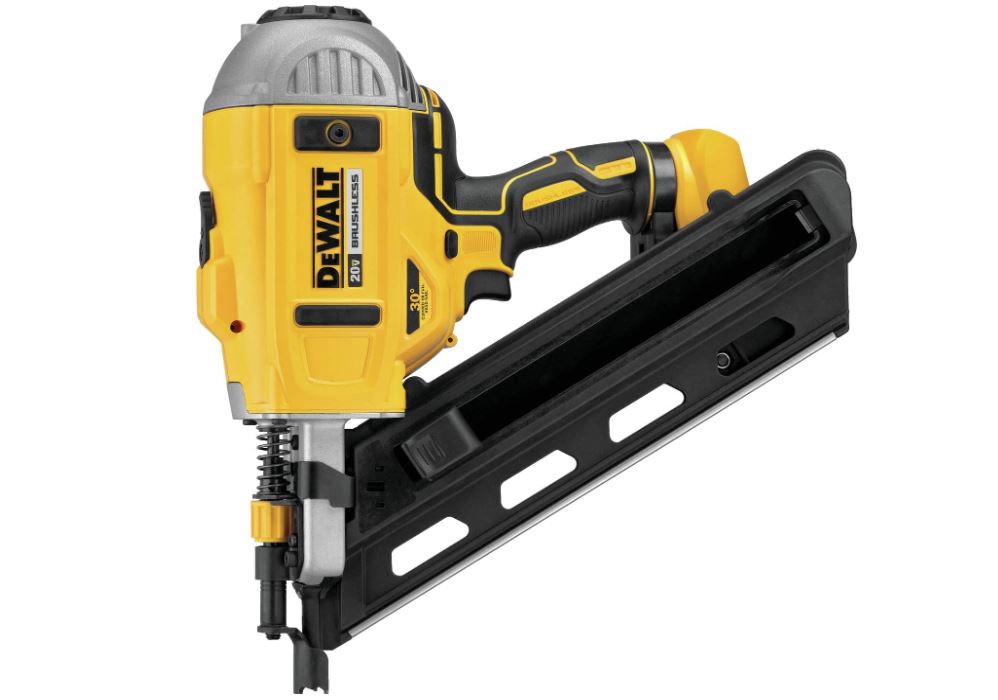
Selling Points:
- Typically the most powerful
- They work quickly
- They can be used for larger jobs
Framing nail guns are the ones that you are going to see most often on construction sites. Framing nail guns are considered the biggest and baddest of them all.
They are used for heavy duty construction, manufacturing, fencing, home building and much more.
Because they are larger and more powerful, they can handle larger framing nails which is how they get their name. Framing nail guns would be perfect for anyone in the construction industry.
Pros:
- Designed for large jobs
- Great for connecting large pieces of material
Cons:
- They can be heavy
Finish Nailer

Selling Points:
- Great for molding
- They use long, skinny nails
- Best for finish carpentry
If you do a lot of renovations and remodels, you are probably going to want to keep a finish nailer handy.
These typically use long, skinny screws that are designed to secure molding, trim, baseboards and paneling.
You can also use a finish nailer on furniture and cabinetry. They are not as powerful as framing nailers but they are designed for more delicate work.
Pros:
- Lightweight
- Great for aesthetic work
Cons:
- Niche use
Brad Nailer

Selling Points:
- Good for trim work
- Used for furniture repair
- Suitable for brad nails
The brad nailer is similar to the finish nailer. It is used for light duty work and the gauge of nail they take is very small.
In general, you are going to want to use a brad nailer if you do a lot of precision work such as furniture repair.
Another benefit to using a brad nailer is that doing so may negate the need to use wood putty to cover up nail holes. That’s because brad nails are very small and they don’t leave much of a mark on wood.
Pros:
- Easy to handle
- They may negate the need to use wood putty
Cons:
- Underpowered
Pin Nailer
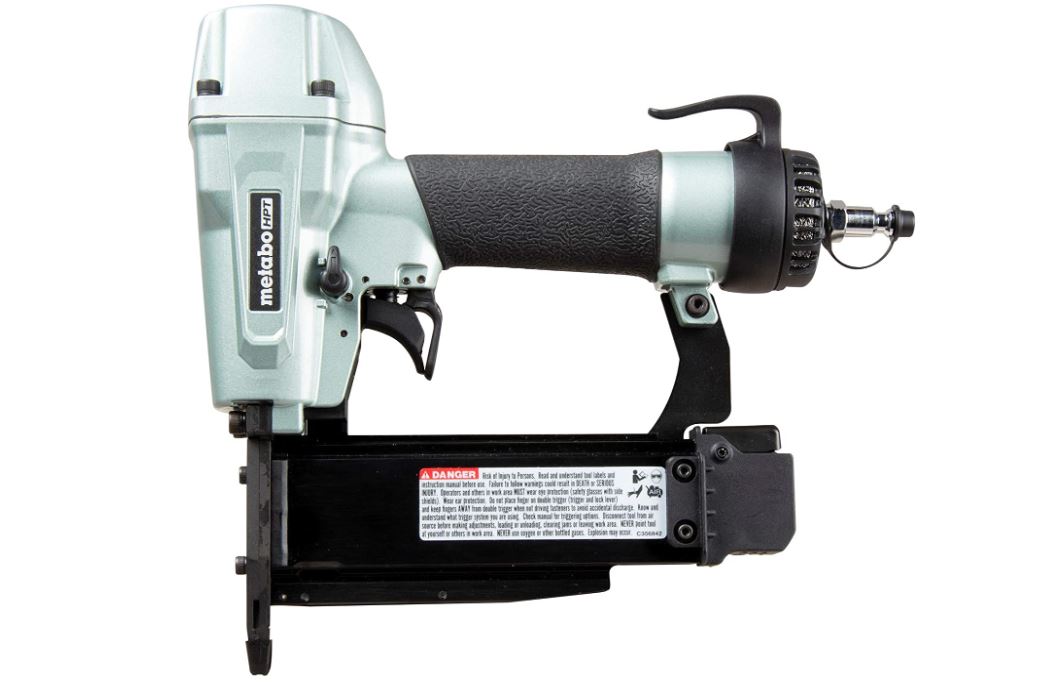
Selling Points:
- Good for craft work
- Lightweight
- Used with 23-gauge staples
A pin nailer is what you use when you are working with very delicate trim. Again, these are useful in finish carpentry.
You can also use these kinds of nailers for cabinet doors and small craft projects.
Pros:
- Cheap nails
- Used for precision work
Cons:
- Narrow usage
What Wattage Do We Need In Our Nail Gun?
If you are using an electric nail gun, you need to consider the type of work you are doing. In general, you are going to want a 4000+ watt nail gun for framing and other heavy-duty applications. However, keep in mind that most modern nail guns allow you to adjust the power which makes them more versatile.
How Do Air Powered Nail Guns Work?
Air-powered nail guns, also called pneumatic nail guns, work with compressed air. You need to hook them up to a compressor via an air hose. The gun uses the highly compressed air from the compressor to propel the nail into the object.
Nail Gun Vs Brad Nailer
A brad nailer will be generally less powerful than a regular nail gun. With a brad nailer, you will also be using smaller gauge nails. While brad nailers are great for finish carpentry, they can’t handle the heavy-duty jobs that regular nail guns can.
Nail Gun Vs Staple Gun
Again, a nail gun will be more powerful than a staple gun. Staple guns are typically used to secure roofing paper, tarps and other lightweight materials. They use staples instead of nails.
Staple guns are cheap and useful; but they are unfit for most construction applications. You may also be able to use a staple gun in upholstery.
Brad Nail Gun Vs Finish Nail Gun
Brad nail guns and finish nail guns are similar in many ways. They are both useful for securing trim, baseboards and molding. However, they are both underpowered and only take certain kinds of nails.
Nail Gun Vs Hammer
A hammer will undoubtedly be less expensive than a nail gun and will not require any power source. However, they may be more taxing on the body and they do not allow you to drive mails as quickly as nail guns.
Electric Nail Gun Vs Air-Powered Nail Gun
In general, an electric nail gun will not offer the same kind of driving power as an air-powered nail gun. However, electric nail guns tend to be cheaper and you don’t have to deal with any compressors.
Angled Nail Guns Vs Straight Nail Guns
Angled nail guns tend to have shorter handles and are overall smaller than straight nail guns. Therefore, angled nail guns tend to be better when you are working in tight or cramped spaces.
Straight nailers tend to be more powerful though.
Framing Nail Gun Vs Finishing Nail Gun
A framing nail gun will always be more powerful than a finishing nail gun. However, finishing nail guns are heavier and more expensive.
FInishing nail guns are better for precision work; but they are unsuitable for attaching large pieces of material.
Nail Gun Vs Drill
You would use a drill when you are working with screws, not nails. Drills are handy when you need to drive screws. Nail guns on the other hand are only used with, you guessed it, nails.
Best Overall Nail Gun
DeWalt 20V Max Framing Nailer
We like this DeWalt nail gun as our overall choice because it offers the power of a pneumatic nail gun in the package of a cordless electric nail gun.
It can be used with a wide variety of fasteners as well.
You can easily adjust the depth of your drives without a tool and there is a dry lockout feature. The magazine is loaded at an angle of 33 degrees so you get some wiggle room when you need to get into tight spots.
You can also choose between sequential and bump-fire modes. This is a very reliable nail gun that is produced by one of the best power tool manufacturers in the country.
Obviously, this would be a great choice for anyone who works in construction or needs a heavy-duty nail gun.
Pros:
- Works with a variety of fasteners
- Durable design
- Dual-speed motor
Cons:
- Jams when you get low on nails
Overall Score: 97/100
Check Out More Reviews Here:
Best Battery Powered Nail Gun
Ryobi P325 One+ 18V Lithium Ion Battery Powered Cordless 16 Gauge Finish Nailer
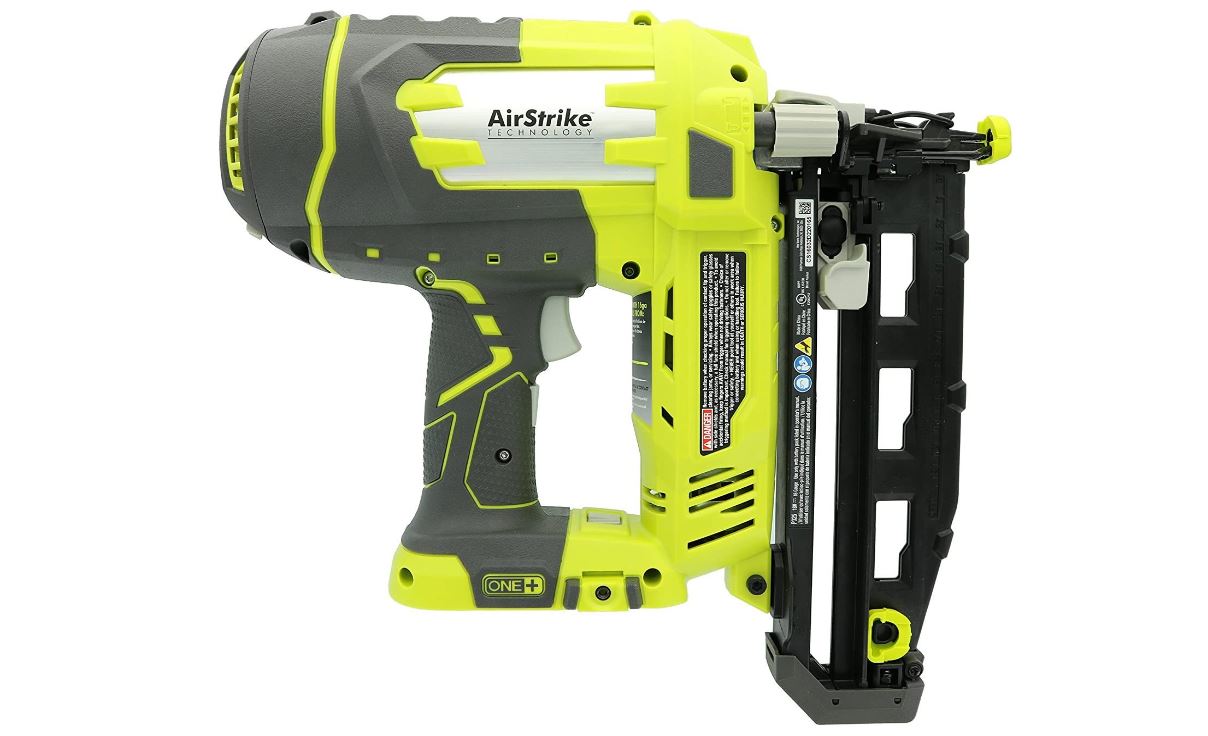
The Ryobi P325 One+ 18V Lithium Ion Battery Powered Cordless 16 Gauge Finish Nailer uses a rechargeable lithium-ion battery that lasts about 4 hours on a full charge.
It also has an LED light near the nose so you can see exactly what you’re doing.
The Ryobi P325 One+ 18V Lithium Ion Battery Powered Cordless 16 Gauge Finish Nailer would be great for anyone who does any light trim work, remodeling or basically non-framing.
You can adjust the depth of the nail without using any tools and it’s very easy to clear nail jams with this gun.
When you are low on nails, there is an indicator light that illuminates to warn you. This feature is designed to help prevent dry firing and prevent jams.
You can also use the battery from any other Ryobi One+ power tools with this nail gun.
Pros:
- Compatible with other Ryobi One+ batteries
- Lightweight (7.3 pounds)
- Great for finish carpentry
Cons:
- Battery takes a long time to charge
Overall Score: 95/100
Check Out More Reviews Here:
Best Air Powered Nail Gun
Powersmart 18-Gauge Pneumatic Brad Nailer
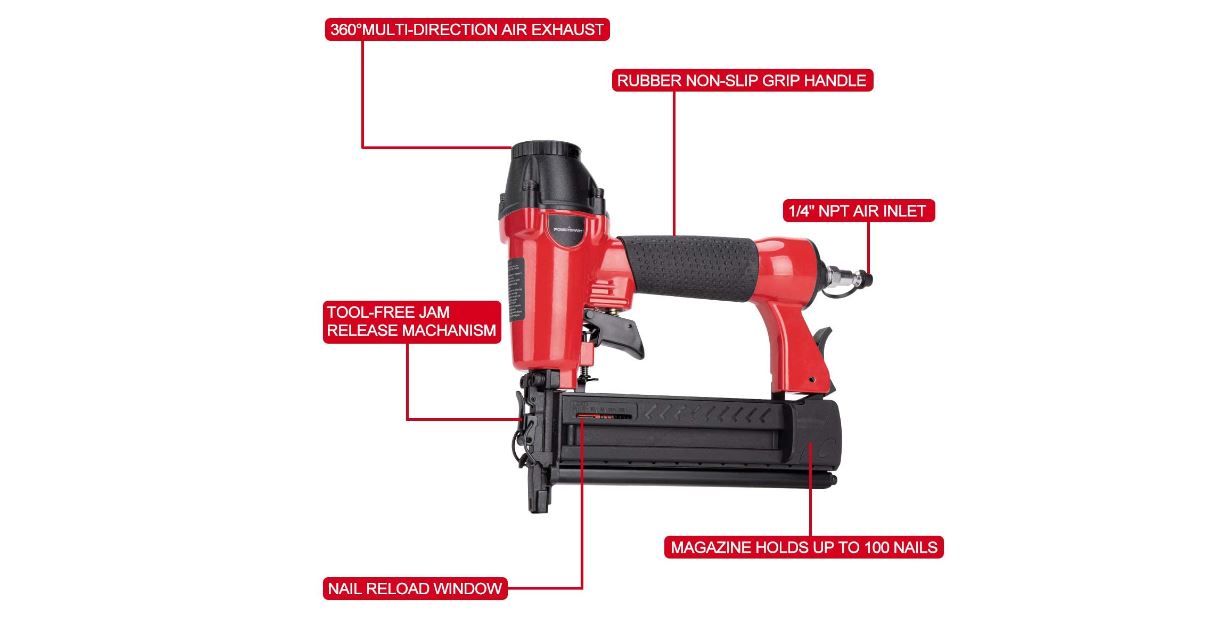
Selling Points:
- Suitable for 18-gauge brad nails
- Tool-free jam release feature
- Works with staples too
The Powersmart 18-Gauge Pneumatic Brad Nailer would be great for anyone who doesn’t want to deal with a heavy nail gun.
It has an aluminum body and the tool itself weighs only 2.4 pounds.
So if you find yourself working long hours on cabinets, furniture or molding, the Powersmart 18-Gauge Pneumatic Brad Nailer would be a good fit for you.
It can be used with staples and brad nails.
This is a pneumatic nail gun which means you will have to hook it up to a compressor. What we really liked about this nail gun is that it will keep up with you, hour after hour.
It offers power that doesn’t diminish over time and the precision you need to handle more delicate projects like flooring.
Pros:
- Very lightweight
- Easy to use
- Very affordable
Cons:
- Staples get jammed easily
Overall Score: 94/100
Check Out More Reviews Here:
Nail Gun FAQs
Is a 16 or 18 gauge nail gun better?
In general, a 16-gauge nail gun will be better. That’s because they are more versatile. They can essentially do all the jobs that an 18-gauge nail gun can do and more.
16-gauge nails provide a stronger hold so they can be used to attach larger, denser pieces of wood.
Do I need a 15 or 16 gauge nailer?
That will depend on the type of wood that you usually work with and the type of work you usually do.
If you are dealing with dense or thick types of wood, you should play it safe and use a 15-gauge nailer.
A 15-gauge nailer will be able to handle beefier nails that are typically required for heavy-duty work.
However, if you are doing lighter finish work, then a 16-gauge nailer may be more appropriate.
What nail gun is best for DIY?
Again, it will depend on the type of DIY you are doing. If you are just making some small repairs around the house, a battery-powered brad nailer will do the trick.
What size nail gun do I need for 2×4?
If you are working with 2×4’s then you will most likely need a framing nailer. You will probably also need to use 3.5 inch nails to ensure a strong bond.
What are 15 gauge nailers used for?
In general 15-gauge nailers are used to install trim, molding, baseboards and door jambs.
What is a 18 gauge nailer used for?
An 18-gauge nailer is suitable for use with nails between 0.5 and 2.5 inches in length. They are typically used for finish carpentry such as installing decorative trim and paneling.
What is a 23 gauge nailer used for?
A 23-gauge nailer is what you will use when working with delicate wood. These are typically finish nailers that are used with molding and trim.
Can I use 18 gauge nails for the baseboard?
Yes. You will typically use 15 to 18-gauge nails when you are working with trim and baseboards because these kinds of nails have very little chance of splitting the delicate wood used for these projects.
Can you frame with 15 gauge nails?
It is not advisable to use 15-gauge nails for framing. In fact, you should never use a 15-gauge nail for any kind of structural work.
They are typically reserved for indoor work such as door casings, molding and installing solid-core doors.
What size nail gun do I need for framing?
A good type to stick to is 30-40 degree framing nailers. These are used commonly on construction sites and can be very useful in tight spots.
What is the longest nail you can use in a nail gun?
It depends on the type of nailer you have. For instance, if you are working with a finishing nailer, you can’t use anything longer than a 2” nail.
Do all nail guns require a compressor?
No. There are battery-operated nail guns that do not require a compressor as they do not rely on compressed air for driving power.
Which nail gun uses the smallest nails?
That would be the pin nailer. Pin nailers can be used with very small nails and staples.
Can you use a nail gun on plaster walls?
Yes; but you are going to want to use a brad nailer, finish nailer or a pin nailer.
Final Thoughts
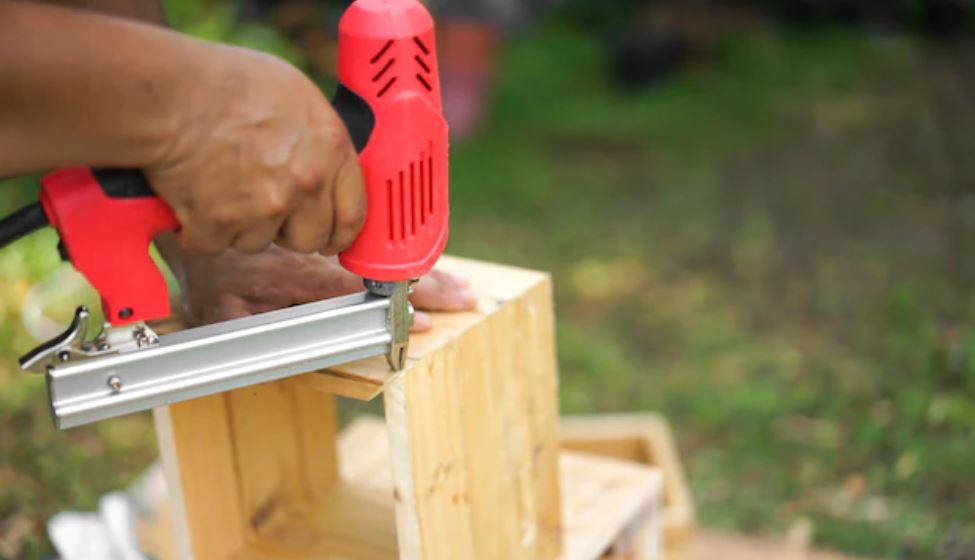
Now, you should have a good idea of what kind of nail gun you need for the type of work and projects you do.
Be sure to review the topics we covered when it comes time to buy your own nail gun and check out some of the models we highlighted!




